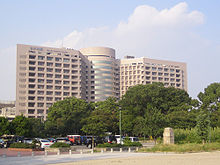Nagoya University
Renowned for its contributions in physics and chemistry, the university has been the birthplace of notable scientific advancements such as the Sakata model, the PMNS matrix, the Okazaki fragment, Noyori asymmetric hydrogenation, and the Blue LED.[9] Features of ITbM include having mix lab and offices, well-furnished with many high-quality instruments, and having English-speaking staff in the administration to facilitate the internationalization of the institute.[14] The institute aims to contribute to solving global environmental issues and the space-related advancement of mankind and society, while also furthering the cooperation between academia and industry.[18] KMI was established in 2010 as an international research hub for interdisciplinary particle physics and astrophysics, and was named after 2008 Nobel Prize winners Makoto Kobayashi and Toshihide Masakawa.[23] The federation was founded in 1961, and aims to help facilitate "better communications between circles, increase in literacy of students, encourage better understanding of each other and enhance friendship, as well as promoting and developing cultural activities.[54] These programmes, conducted entirely in English, span various majors across undergraduate and graduate levels in fields such as humanities, law, economics, science, engineering, agriculture, and medicine,[55][56] with yearly matriculation in October.Undergraduate students complete a thesis or lab work, while graduate programmes are research-focused, requiring applicants to align with professors' research interests.NUPACE, a short-term exchange program lasting four to twelve months, has welcomed over 2,300 students from 155 institutions, offering a range of courses in English and Japanese.Participants also have the option to engage in research under faculty guidance and enjoy benefits like student insurance counseling and accommodation in international dormitories.Other exchange programmes include Campus Asia for discussions on East Asian law and political science, JUACEP for engineering research in Japan, the US, and Canada, NUSIP focusing on automobile technology, and NUSTEP for intensive Japanese language learning.




Nagoya City UniversityPublic (national)PresidentUndergraduatesPostgraduatesNagoyaColorsJapanese nationalresearch universityChikusa-ku, NagoyaImperial UniversitiesEmpire of JapanSakata SchoolHirata SchoolNobel PrizeKyoto UniversityUniversity of TokyoJapanese EmpireFumihiko MakiSakata modelPMNS matrixOkazaki fragmentNoyori asymmetric hydrogenationBlue LEDDesignated National UniversitiesGifu UniversityTōkai regionJapanese Nobel laureates in Natural SciencesSyukuro ManabeSeventeen-article constitutionCoordinating Committee for Earthquake PredictionChubu Electric PowerToyota Motor CorporationMakoto KobayashiToshihide MasakawaOsaka UniversityyakisobakakigōriUniversity rankingsT. ReutersShimano(Asia version)Program rankingsT.ReutersAcademic Ranking of World UniversitiesQS World University RankingsTimes Higher Education World University RankingsThomson ReutersToyo KeizaiShoichi SakataNobel Prize in PhysicsCKM matrixToshihide MaskawaIsamu AkasakiHiroshi AmanoHiroomi Umezawaquantum field theoryYasushi TakahashiWard–Takahashi identityBunji SakitasupersymmetrySumio Iijimacarbon nanotubesAkira Tonomuraelectron holographyMorinobu Endocarbon nanofibersKoji NakanishiColumbia UniversityRyōji NoyoriNobel Prize in ChemistryOsamu Shimomuragreen fluorescent proteinYoshito KishiHarvard UniversityTsuneko OkazakiOkazaki fragmentsL'Oréal-UNESCO Awards for Women in ScienceMasatoshi Takeichicell biologistCadherinCanada Gairdner International AwardNobel Prize in Physiology or MedicineYoshimasa HirataReiji OkazakiHisashi YamamotoMedal of Honor with a Purple RibbonTohru FukuyamaShigefumi MoriFields MedalistsMasayoshi NagataHilbert's fourteenth problemGoro AzumayaAzumaya algebraMasatake KuranishiCartan-Kuranishi TheoremTomio KubotaTakashi OnoHiroshi Umemura (mathematician)Painlevé equationsGalois theoryTang JunUichiro NiwaItochuJapan Post HoldingsShoichiro ToyodaToyotaSai Khaing Myo TunNational Unity Government of MyanmarDeputy Prime Minister of VietnamKen Prayoon ChengAttachmateProximex/Tyco InternationalMeiji UniversityNational Seven UniversitiesHokkaidoKyushuTohokuHokudaiScience TokyoTokyo TechUTokyoTsukubaWasedaTop Global University Project